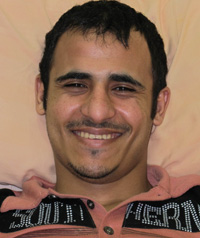Bassam - Sequelae of spinal cord injury (Yemen) Posted on February 1, 2012
Name: Bassam Yaseen Abdo Othman
 Sex: Male
Sex: Male
Country: Yemen
Age: 22
Diagnoses: 1. Sequelae of spinal cord injury 2. Brachial plexus injury
3. Urinary tract infection (has been treated) 4. Bed sores.
Admission Date: 2011-11-23
Days Admitted to Hospital: 35
Bassam was involved in a car accident in February of last year. He suffered a chest injury and his left arm had limited mobility. He was immediately sent to the local hospital and received a CT and MRI and the results showed he had a spinal cord injury at the T2-4, left hemothorax. There was also a peripheral nerve injury in the left arm. He received aggressive treatment at the local hospital and after 3 weeks his condition improved. Bassam received anti-inflammatory treatment for the urinary tract infection 1 week ago. Because of his limited movement ability, multiple bedsores developed throughout the body. At present, Bassam can sit up by himself, but it requires a lot of effort for him to turn over. There is limited movement in the right arm. Bassam has difficulty with everyday tasks.
At the time of admission there was a sacrococcygeal pressure sore about 3*3cms, the depth was 1cm. There was a skin ulceration on both knees. There were bedsores on both heels, the size was 5*5cms, with a black scab. The abdomen was sunken. The liver and spleen were not palpable. There was obvious pitting edema. The muscle tone of both arms was normal. The muscle strength of the right arm was level 5, and the muscle strength of the left arm was level 5-. There was obvious muscle atrophy in the left arm. There was limited movement below the wrist joint of the left arm. The fingertips buckled and were unable to move. The muscle strength of the legs was level 0. The muscle tone of both legs was high. The myoclonus in the left leg was obvious. There was hyperreflexia in the left ankle. There was obvious muscle atrophy in both legs. The tendon reflex of the right arm was normal. The tendon reflex of the left arm was slightly decreased. The tendon reflexes of both legs were slow to react. The abdominal reflex was not elicited. The shallow sensation below the thoracic vertebrae segment 5 was diminished. The deep sensation below the thoracic vertebrae segment 7 was diminished. The bilateral Hoffmann's sign was negative. The left side Babinski's sign was positive. The right side Babinski's sign was negative. Bassam was unable to finish the finger-to-nose-test, the heel-knee-shin test or the rapid rotation test.
We initially gave Bassam a complete examination and he was diagnosed with sequelae of spinal cord injury. Then we proceeded with the nerve nutrition, and improved the blood circulation to increase the blood supply to the damaged neurons. This was combined with daily physical rehabilitation training. Bassam had a urinary tract infection and received positive anti-inflammatory treatment.
After the completion of the treatment, the urinary tract infection had been controlled. After the dressing had been changed, the bedsores on the knees had mostly healed. There is one bedsore, which is 1.0*1.0cm, and 0.5cms in depth, that did not heal at that time. The bedsores on the heels have been reduced to 2.0*2.0cms. The balancing ability while Bassam is in the sitting position is more stable. The pain sensation plane has reached the thoracic vertebra segments 11 and 12. The tuning fork vibration has been extended to both ankle joints. There was obvious muscle contractions in both legs and the muscle strength reached between level 1 and 2. The muscle tone of both legs has noticeably decreased. The myoclonus has been alleviated. The bilateral abdominal reflexes can be slightly elicited.
Before the discharge, Bassam's older brother told the staff at our medical center, "We are so glad to see my brother's improvements. Before the treatment here, my local hospital's nurse did not take very good care of my brother and he had bedsores. My brother has had good improvements at your medical center. He was cared for very nicely after the therapy. He is stronger and has an easier time moving around. It is really something to see how much he has improved."
